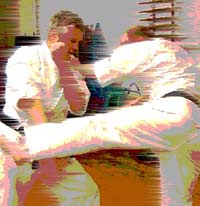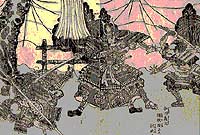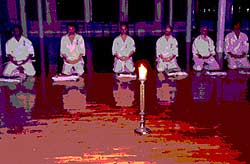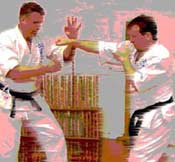Fighting Zen
How Meditation Can Enhance Your Fighting Skills

By Christopher Caile
Editor’s Note: This is the third in a three article
series on meditation (Zen) and the martial arts. This article discusses
how Zen (meditation) skills are actually put to use in fighting and/or
self-defense situations. Part one, “Holding
Hands With Zen: The Martial Arts Connection - An Interview With Jeff Brooks,” discussed
how Zen complements the martial arts by helping develop total concentration
without thought, something that allows greater spontaneity of action.
Part two, “Meditation
- Just Do It!” by Jeff Brooks examined
some of the techniques and methods of meditation itself.
Many martial arts students dismiss meditation as something that is not
useful. It is perhaps interesting, they think, but has little to do with
developing fighting ability. Are the two, in fact, related?
 Historically we know that the Japanese samurai warrior often used meditation
(Zen) as part of his training. And the samurai were noted for their total
commitment to action – having an unsurpassed fearfulness and indomitable
spirit – so much so that they are revered even to this day. Historically we know that the Japanese samurai warrior often used meditation
(Zen) as part of his training. And the samurai were noted for their total
commitment to action – having an unsurpassed fearfulness and indomitable
spirit – so much so that they are revered even to this day.
So what did they know that we don’t? How can something as peaceful,
quiet and introspective as meditation be of any help to you in the midst
of action and violence?
As an introduction to this subject I often ask my students, “How
many of you have ever been in a car accident?” Always a few hands
go up. I then ask what they remember and invariably a student will comment
that everything seemed to go in slow motion as events unfolded – as
if minutes replaced a fraction of a second.
“This is a Zen moment in reverse,” I often tell them. You
were so riveted by the intensity and danger of the moment that your mind
was totally absorbed by it, something so emotionally powerful that events
slowed. Unfortunately, too, the emotion is often so strong that people
can’t react well and often freeze.
Meditation can work to achieve that same clarity, but it also helps
in freeing you from the chains of emotion and thought that can slow your
reactions. It can help you in any situation, especially when you are
actually threatened.
A few years ago in Buffalo I saw an old friend on the street. We stopped
to talk, and he had a huge shiner (black and blue eye). “What happened?” I
asked (I really wondered, since he was a well known teacher of a Chinese
martial art). He seemed embarrassed, to say the least. Finally with a
little prodding he explained that he had been attacked by two young men
outside a bar. One pulled a knife while the other had sent him reeling
by a haymaker. “I don’t know how it happened,” he said. “I
guess I just freaked. I didn’t see the punch coming. All I could
see was the knife.”
That type of reaction, just like in a car accident, is not uncommon.
And most people, even martial artists, aren’t prepared.
Police reports often tell of policemen faced with a high stress, threatening
situation, who react like the driver in a car accident. They report that
things slowed down, but often too the correct actions were not forthcoming.
Here training helps.
The samurai warrior (at least in the times of civil warfare) used a
lot of tools to prepare themselves – strict discipline, hard, relentless
training, meditation (Zen), and often self-hypnosis (Esoteric Buddhist
practices) wrapped in a culture and tradition of absolute commitment
and service. The mind and spirit were developed as readily as physical
and technical skills.
One of the primary differences between the classical martial arts and
sports as we know them in the west is this mental conditioning and training.
This conditioning has in some part been carried over to modern martial
arts, such as judo, karate-do, kendo and aikido. The goal of the “do” (the
way) arts has been to preserve and foster the same spirit, commitment
to purpose and mental development that once characterized the samurai.
In the west, even the most basic concepts of what we know as sports
psychology didn’t develop until the 1970s. People were often excellent
athletes, but mentally they had little preparation. In contrast, the
emphasis on mental conditioning as seen in classical martial arts (and
in some do arts) can actually work to initially slow physical skill development.
Thus, the western athlete often develops faster. But, at the highest
level of performance enhanced mental skills provide an edge. They can
free the body to achieve a higher level of physical performance. Matched
against each other, and with equal skills the athlete or martial artist
with the superior mind set will have advantage.
Thus, in hand to hand warfare or combat, the mind often provides the
edge. Mediation is one of the tools to prepare the mind for high stress
combat situations. The idea was to prepare the mind so it will not be
inhibited by thoughts, intense emotions, fear, and automatic body reactions.
There are many legends about the superior fighting abilities of Zen
monks based on their mindset. In the 17th century, there was a famous
Zen master Shoju Rojin, a bastard son of a Samurai family who suffered
a near death experience and went on to study Zen. He lived as a hermit.
One day a group of swordsmen began practicing nearby, and during a pause
one came up to him. The Samurai boasted that while the monk’s concentration
was superior to theirs, theirs was superior in terms of practicality.
Taking an opportunity to demonstrate their error, the monk suggested
that the warrior try to cut him with his sword. He said that he would
only use his fan (which had a metal backing that allowed it to be used
as a defensive instrument). The swordsman attacked from every angle,
but each blow was deftly parried. Finally exhausted the warrior was forced
to concede that the monk’s abstract concentration was capable of
concrete use.
When the warrior asked how the monk was able to do this, he replied, ”It’s
simple. When your objective perception is clear, you don’t miss
one of ten thousand things.”
 |
Students sit in meditation. The goal
is to enhance their clarity of mind and perception while
reducing the interference of thought, emotion and distraction.
|
|
To understand this concept, let’s examine meditation. When you
sit, you relax in a comfortable position, withdraw your attention while
remaining alert, and clear the mind of thoughts, emotions and feelings.
Often students are told to concentrate on their breath and count to ten,
but to start again if a thought, image or feeling jumpes in.). Sitting
like this you often feel drowsy and the mind can wonder. Don’t
let it. All kinds of images and thoughts flash into the mind. You also
feel twitches, and itches, and your legs often feel uncomfortable as
your mind starts its own little rebellion. But the idea is not to move
or scratch, but just to sit, awake with as clear a mind as possible.
After a while practicing old emotions or memories also bubble up. You
just sit. It can be the most difficult thing you ever have done – nothing.
And it takes a lot of time, years to develop.
Over time just sitting can produce internal changes that transform normal
perceptions and awareness and develop them beyond the norm. You concentration
evolves – toward state of total focused awareness that allows the
slightest nuance of perception or intuition to be acknowledged and not
be clouded by prior experience, or filtered out by distraction or inattentiveness,
or colored by emotion. At its highest distinctions between the viewer
and others or objects are reduced or even eliminated – a physiological
state which allows the unconscious mind and body act freely to use the
training programmed into the muscles and auto responses of the body.
Many people think of Zen as a religion, Buddhism. Yes, it is this, but
it can also be practiced as a mental practice devoid of religion. This
is the meditation I am discussing here. I used to attend a Zen monastery
just north of New York City in the Catskills and was often surprised
to find people of all religions. There was even a priests that often
attended.
In Japan too, it was not just the samurai who used Zen’s meditative
mind set. A friend of mine who lives in Japan took a class in flower
arranging. She noted that the biggest difference between western florists
and those she studied with was the ability to work without thought. “In
the US,” she said, “I thought a lot about how things were
arranged, while in Japan I was encouraged not to.” This same mindset
is also found in those who perform the Japanese tea ceremony (Chado).
But in fighting the challenge of clear mind, clear perception, is greater
because the mind has greater assaults. A samurai going into battle knew
that he would often fight another, face to face, and that one or both
of them would die. But even in hard competitive sports the mental barriers
can be challenging. Again it depends on the level of physical combat
and danger.
In point or light contact practice fighting you can develop your movement
and reflexes, but your mind isn’t really threatened. You might
lose a point or be made to look bad, but that’s a loss of ego.
Even if you practice heavier contact, rules and safety equipment usually
protect you. You may fear getting an injury, but this is a far cry from
the fear of possibly getting really hurt, or even worse – killed.
A real confrontation or attack creates a cascade of emotion and fear
not experienced in tame dojo exercises.
Anger can be just as bad. It can build up, flair the nostrils and make
you want to strike out or kill – something that can also make you
forget everything you have learned – your training, common sense,
and even your own safety.
 |
You can maximize physical performance
and spontaneity of action by eliminating the interference
of thought and emotion. Instead of thinking about your
opponent or focusing on his techniques, or yourself, become
totally absorbed in your perceptions so that you can see
your opponents technique before they develop.
|
|
I learned quite a bit about the mental side of martial arts early on.
It was 1961 in Japan. I was 18, a new student of Mas Oyama’s Kyokushinkai
karate. And kumite (practice fighting) was violent. I was often frozen.
Day after day in class I knew I was going to get hurt again. And there
in front of me would be my opponent, arms out in front of him and often
with a slight smile. Day after day I would be knocked to the ground,
struggle up to be knocked down again. Over the first few months my toes
got so red and swollen they could hardly bend. My shins became black
and blue and swollen. I had broken knuckles and cracked ribs. I suffered
a cracked jaw, and teeth had been kicked out, wired in only to be kicked
out again. And each day I would be there again fighting. I remember how
I would set my defense and wait. I would try to think of how to avoid
the attack, of the techniques the my opponent had used before, of what
I should do. It didn’t help. And I had hitch hiked half way around
the world and signed up for this.
Late one night I talked the situation over with Donn Drager with whom
I was living in Tokyo. Donn talked about fear and how it could overwhelm. “If
you are afraid of the sword, you will die by it,” he said. He knew
I mediated and advised me to use what I had learned. “Stop thinking,” he
said “and just accept the pain, almost welcome it.” He pointed
to his head and said “it’s this that is getting you hurt.
Tomorrow just relax and try to see your opponent as clearly as yourself,
with the same clarity of mind as when you meditate.” Wise words.
That night I meditated again. I also pictured kumite (practice fighting)
and how I would clear my mind and not think of how to fight. I did this
for hours. And the next day was the first day I wasn’t hurt in
practice fighting. Donn’s advice provided a turning point for me,
Zen advice for my sorely aching body. I must have evolved to a point
where just a little push moved me over the mental edge to another state
of consciousness.
I had been introduced to meditation while making my way to Japan. I
had been hitchhiking up through the jungles in the panhandle of Thailand
from Malaysia. Along the way I slept outside in a small village. A Buddhist
monk somehow heard there was a stranger visiting in the area who spoke
English, and he sought me out. He invited me to visit his Buddhist monastery
with the idea that he could practice his English. It was there that I
learned about meditation. For about there weeks I sat daily with a group
of 100 monks dressed in bright orange robes. I found solace in the mediation
and thereafter started practicing regularly.
Donn’s advice was reflected years later when I read what was to
become one of my favorite books, ”The Unfettered Mind.” The
book features the writings of the famous Zen Monk Takuan Soho (translated
by William Scott Wilson) (1) that were addressed to a master of the sword.
Soho talks of “stopping the mind,” of how judgments or thoughts
of the attack, the other’s intention, or your own defense, even
fear, can undermine you by detaining the mind.
|
Modern students of Itto-Ryu Kenjustu practice
their sword techniques just as their samurai forefathers
did before them, ever aware of each other, proper distance
and the constant danger of the sword.
|
|
In the story about the Chinese teacher of martial arts noted above,
his mind was actually frozen by fear, which stopped his body from reacting.
Years of training meant nothing. “If your mind is diverted in any
way, you will falter,” consoled Takuan Soho. “The mind must
be immovable – that is, not distracted, detained or occupied by
any thought, judgment or emotion – not congealed in one place but
instead stretched through the entire body and self. It must have a total
awareness and sensitivity without focus, and thus will be able to flow
with events without getting attached to them (No-Mind, No-Thought).”
If one empties the mind, the function of the intellect disappears –“arms,
legs and body remember what to do, but the mind does not enter into this
at all,” said Takuan Soho.
All this adds up to one point: meditation helps you get your mind out
of your fight. Just as in meditation, in fighting you try to maintain
clarity of conscious. Don’t think what you should do, don’t
try of guess what the opponent’s technique or techniques will be,
don’t let fear strangle your reactions or hold you back. Let your
consciousness become one with your opponent so that you almost feel a
part of him or her, so much so you can sense an offensive technique even
before it appears. And when a technique is thrown, don’t focus
on it. Block, avoid or absorb the technique, but always look, feel and
let your mind use its intuition to sense the next action, the following
technique or movement.
This mental state will let you react faster, move more spontaneously,
see things as they happen or intuitively sense things as they are about
to happen. For some, action will actually seem to slow down. This slowing
down of action is not exclusive to the martial arts. Other athletes sometimes
call it the “Getting in the Zone.” Baseball player Ted Williams
is often quoted as saying that when he was at bat, he could actually
see the stitches on the baseball turn over as the ball came toward him.
Hockey goalie Dominick Hasek likewise commented in a post-game interview
in 1997, when he was asked about his phenomenal goal blocking ability,
that for him the puck seemed to slow down so it was easy to see and block.
About The Author:
Christopher Caile is the Founder and Editor-In-Chief
of FightingArts.com. He has been a student of the martial arts for
over 43 years. He first
started in judo. Then he added karate as a student of Phil Koeppel
in 1959. Caile introduced karate to Finland in 1960 and then hitch-hiked
eastward. In Japan (1961) he studied under Mas Oyama and later in
the US became a Kyokushinkai Branch Chief. In 1976 he followed Kaicho
Tadashi
Nakamura when he formed Seido karate and is now a 6th degree black
belt in that organization's honbu dojo. Other experience includes
judo, aikido, diato-ryu, kenjutsu, kobudo, Shinto Muso-ryu jodo, boxing
and
several Chinese fighting arts including Praying mantis, Pak Mei (White
Eyebrow) and shuai chiao. He is also a student of Zen. A long-term
student of one branch of Traditional Chinese Medicine, Qigong, he
is a personal disciple of the qi gong master and teacher of acupuncture
Dr. Zaiwen Shen (M.D., Ph.D.) and is Vice-President of the DS International
Chi Medicine Association. He holds an M.A. in International Relations
from American University in Washington D.C. and has traveled extensively
through South and Southeast Asia. He frequently returns to Japan
and
Okinawa to continue his studies in the martial arts, their history
and tradition. In his professional life he has been a businessman,
newspaper journalist, inventor and entrepreneur.
|